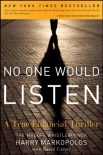No One Would Listen: A True Financial Thriller by Harry Markopolos (rainbow fish read aloud .txt) 📗

- Author: Harry Markopolos
Book online «No One Would Listen: A True Financial Thriller by Harry Markopolos (rainbow fish read aloud .txt) 📗». Author Harry Markopolos
We were beginning to see him as he really was: a monster preying on others; a master con artist.
Unfortunately, we were only at the beginning of our investigation. We couldn’t even imagine how much of that we would encounter in the next eight years.
Any lingering doubts any of us had that Bernie Madoff was running a multibillion-dollar scam, maybe even the biggest fraud in history, had long since disappeared, but the question that Neil, Frank, and I continued to debate was: What kind of scheme was it? Was he front-running, was it a Ponzi scheme, or was it maybe even something else? Obviously we weren’t shocked to find gambling in Casablanca, or swindlers on Wall Street. The famous 1950s bank robber Willie Sutton was quoted as explaining that he robbed banks “because that’s where the money is.” It’s probably a good thing Willie Sutton didn’t know about Wall Street.
Throughout history, where there has been money to be made there have been crooks, con artists, and swindlers ready to sell get-rich-quick (or sometimes slowly but consistently) dreams to willing investors. And with the proliferation of new and extremely complicated financial products, there was more money to be made on Wall Street in the past three decades than probably anyplace else at any time in history. Although Bernie Madoff surrounded himself with all the symbols of success and respectability, in fact he was no different than George Parker, who made a career out of selling the Brooklyn Bridge to tourists, the infamous con man Joseph “Yellow Kid” Weil, or even the legendary Charles Ponzi.
The mechanics of a Ponzi scheme are pretty simple. People are offered an opportunity to invest in a business that seems real and even logical—it’s often a business that supposedly exploits some kind of financial loophole—in return for unusually large and rapid profits. These initial investors get every dollar they were promised; they usually earn a profit large enough to make them boast about it to everyone they know. Other people rush to get into this business to receive the same kind of returns, sometimes begging the perpetrators to take their money. In fact, in a true Ponzi scheme there is no underlying business and there are no investments; there is nothing except the cash coming in and the cash going out. The initial investors are paid with seed money used to set up the scam. From that point until the scheme collapses, investors are paid with funds received from later investors. Generally, a substantial number of these investors reinvest their supposed profits in the business. On paper, they can become wealthy, but only on paper. The scheme can last as long as new investors continue to hand over their money so old investors can be paid.
It didn’t originate with Charles Ponzi. A similar scheme is a plot element of Charles Dickens’s 1857 novel, Little Dorrit. In 1899 a man named William “520 Percent” Miller supposedly stole $1 million by offering investors a return of 10 percent weekly on their money. At one time this type of fraud was known as a “rob Peter to pay Paul” scheme. Ponzi just perfected it. Ponzi’s scheme was actually based on a legitimate financial quirk. In 1919 people were able to buy international postal coupons in one country that could be exchanged in another country for stamps that would cover the entire cost of a reply. He realized that if the cost of postage differed in the two countries, it was possible to redeem coupons in one country for a profit. Potential investors who investigated would discover that this actually was true.
Ponzi began promising investors that by investing in postal coupons he could double their investments in three months. And for the initial investors that’s what he did. His company, ironically called the Securities Exchange Company, grew so quickly that he had to hire agents to collect the money for him—and he paid them as much as 10 percent of the money they brought in. The scam grew into a regional frenzy. Thousands of people invested their life savings, and other people borrowed money or mortgaged their homes to get in on this get-rich-quick opportunity. It was estimated that more than half the officers of the Boston Police Department were investors.
Even then there were whistleblowers trying to warn people that this was a con game. Ponzi successfully sued a Boston financial writer for libel—winning a $500,000 judgment. There were obvious red flags that everyone ignored; for example, one of his former publicity men wondered why Ponzi had deposited several million dollars in a Boston bank that paid only 5 percent interest when he could easily have doubled it by investing in his own company. Obviously there was no answer to that. That same publicity man later wrote that Ponzi was not very good at math and could hardly add.
Eventually, Clarence Barron, the publisher of Barron’s financial newsletter, was asked to investigate Ponzi’s business. Barron discovered that to cover Ponzi’s investors there would have had to be about 160 million postal coupons in existence—and according to the U.S. Postal Service there were only 27,000. That was amazingly similar to our discovery about the number of options on the OEX. But even with all the evidence beginning to pile up, people continued to invest with Ponzi. They refused to believe it was





Comments (0)